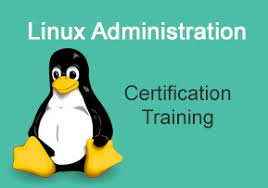Linux Administration Certification Training

The Linux Administration Certification Training course helps the
candidate grow more in this field and sharpen their minds about being
Linux Administrator and professionals. Being a professional in Linux
administration training, a person can run various applications and
prepare himself to perform different functions. Linux professionals can
maintain the administration when it comes to security and can create a
network configuration.
Why should a candidate take this course?
According
to the website named Linux.com, The huge country China will be moving
towards Linux by the end of the year 2020, adopting the 'de
Windowsifying' process.
The following are the Multinational companies which use Linux all across the world:
* IBM
* Wikipedia
* New York Stock Exchange
* Twitter
* Google
* NASA
According to the website named Indeed.com, the average salary annually a Linux Administrator has is $95k.
Course Curriculum
Learning objectives: Under this chapter, the candidate will learn about the basics and Key components of
Linux administration and structure. Guidance for installing the Centos7 Operating system initialization and some fundamentals to get started with it.
Topics:
* Introduction
* Linux architecture
* Kernel
* GRUB (Modify the system Boot Loader)
* CLI (Access a shell prompt and issue commands with correct syntax. Use input and output redirection.
* Delete, copy and move files and directories
* Basic Commands
* Man Pages
* Annie's quizzes
* Q and A
* Installation
* Boot process
* System initialization
* GUI
* Create and Edit text files
* Introduction to Bash Shell
* Editors
* Boot system into different targets automatically and manually.
* LAB
* Quick Recap
Learning objectives: The candidate will be going to learn about the following things under this chapter:
Topics on essential networking tools needed.
Package management, including installing, removing software along with updating the software.
CMD's for monitoring and processing the system.
Topics:
* Shutting down and rebooting the system
* Installing and removing software
* RPM verification
* Using Yum
* Configuring local repositories
* The properties of a process
* Killing processes and sending signals to a process
* Monitor them
* Adjust process priority
* Statically or dynamically configure the networking and hostname resolution.
* LAB
* Quick Recap
* Securing a single-user mode (SU login)
* RPM Package Manager
* RPM queries
* About YUM
* Searching packages/files
* What process are?
* Parent processes and child processes
* How to start processes
* Identify CPU/ Memory intensive processes
* Start/stop/check the status of network services
* Annie's quizzes
* Q and A
Manage services, essential files, directories, along configurations. Also will be knowing about essential data utilities that process the data.
Topics:
* Control Services and Daemons
* Dev and proc directories
* Awk
* Use grep and regular emotions and expressions to analyze text.
* Dump restore
* Annie's quizzes
* Q and A
* Stop and start and configure services to start automatic at boot.
* System documentation under usr/share/doc
* Sed
* Archive, compress, pack and unpack and uncompress files using tar, star, gzip, and dzip2.
* Locate and interpret log files
* LAB
* Quick recap
Topics:
* Network time protocol
* Cron, Controlling access to cron
* Daily Cron Jobs
* Schedule tasks using at
* LAB
* X windows
* SSH: Secure Shell (remote access system using ssh, SCP, passwordless SSH,
* Configure key-based authentication for SSH
* Quick Recap
* System Crontab file
* Anacron scheduler
* Annie's quizzes
* Q and A
existing account, deleting the current version, and discussions regarding the network users and permission regarding files strategies.
Topics:
* Adding a new user account
* Group Administration
* Switching accounts
* Network users
* SUID and SGID Executable
* The sticky bit
* Modify/ Delete the existing user account
* Changing file ownership
* Permissions on directories
* Changing permissions
* Annie's quizzes
* Q and A
* User Private Groups
* Password aging policies
* Sudo access
* Authentication configuration
* SGID directories
* Changing file group ownership
* How permissions are applied
* Access control lists
* LAB
* Quick recap
Topics:
* Device Recognition
* Making file systems
* File systems and types
* tune2fs
* Mounting file systems with Mount
* Handling Swap files along with Partitions
* NFS share for Group collaboration
* Use Kerberos to control access to NFS network shares
* Annie's quizzes
* Q and A
* Disk Partitioning
* Managing partitions
* Labels
* Unmounting file systems
* NFS server and NFS client
* Mounting NFS file systems
* Quick Recap
candidates under this system.
Topics:
* Select file types, Symbolic links (ln -s), Inodes and directory entries
* Hard links
* Preserving links while copying and archiving
* Configuring the Quota System
* Setting Quotas for Users
* Reporting Quota Status
* What is Logical Volume Manager (LVM)?
* Creating Logical Volumes
* Resizing Logical Volumes, Network Interfaces
* IPv4 Addresses
* Dynamic IPv4 Configuration
* Static IPv4 Configuration
* Device Aliases
* Routing Table
* Default Gateway
* Verify IP Connectivity
* Defining the Local Host Name
* Local Resolver
* Remote Resolvers
* Verify DNS Connectivity
* Network Tools
* NFS server and NFS Client
* NFS share for group collaboration
* Annie’s Quizzes
* LAB
* Q & A
* Quick Recap.
types of Apache and DNS configurations.
Topics:
* Configure BIND to function as a caching-only DNS server
* Configure a caching-only name server to forward DNS queries
* Troubleshoot DNS client issues
* Configuring BIND options
* Configuring directory location for zone files
* Apache Overview, Apache Server Configuration
* Virtual Hosts
* Apache Access Configuration
* Deploy a basic CGI application
* Configure TLS security
* Configure private directories
* Analyze and store logs
* Annie’s Quizzes
* LAB
* Q & A
system.
Topics:
* Shell Scripting basics
* Loops
* Shell variables
* Arrays
* writing scripts
* Kerberos authentication Annie’s Quizzes
* LAB
* Q & A
* Quick Recap.
Topics:
* Configure SMB to provide network share to clients
* Configure mail server to forward all emails to Central mail server
* Introduction to KVM Virtualization
* Virtual Machine installation
* Configuring Virtual Machines
* Install centos systems as virtual guests
* Administer systems to launch virtual machines at boot
* Annie’s Quizzes
* LAB
* Q & A
* Quick Recap.
Containers, Aggregations, IPTables, and Bridging.
Topics:
* SELinux Overview
* SELinux Tools
* SELinux Contexts
* SELinux Booleans
* Use SELinux port labeling to enable services to use non-standard ports
* Diagnose and address SELinux policy violations
* Configure firewall settings
* N/W port-security
* Route IP traffic and create static routes
* Boot level security (GRUB)
* Security need for TCP wrappers
* Configure aggregated links between two systems
* Use firewall and associated mechanisms such as rich rules
* zones and custom rules
* To implement packet filtering and configure network address translation (NAT)
* Use /proc/sys and system to modify and set kernel runtime parameters
* Linux Containers
* Annie’s Quizzes
* LAB
* Q & A
* Quick Recap
how to restore operations. They will gain the skill of performing the backup.
Topics:
* Install MariaDB
* Schema Creation and Writing Queries
* backup & restore operations
* Configure a system as either an initiator that persistently mounts an iSCSI target or an iSCSI target
* Annie’s Quizzes
* LAB
* Q & A
* Quick Recap.
Topics:
* Ipv6 configuration
* kickstart installation using NFS
* HTTP services
* Setting Grub Password
* Setting the root password for single-user mode from the Grub page
* Configure systems to mount file systems at boot by Universally Unique ID (UUID) or label
* List, create, delete partitions on GPT and MBR disks.
Linux Professional.
Topics:
* Include questions from all the topics covered so far
* New troubleshooting scenarios
* Writing Scripts for given use cases.
* Project for Certification
* Q & A
* Quick Recap.
Course Description
The Linux administration certification training course gives a detailed knowledge of concepts, key
components, and other things to become a Linux Professional this course. Whether it's the security or the
administration, the Linux administration certification training course covers it all.
* Package management & Process monitoring
* Services, Utilities, Important Files and Directories
* System services
* User Administration
* File System Security and Management
* Advanced File System Management
* Server Configurations
* Shell Scripting and Kerberos
* Configuring SMB Service, SMTP service, and Virtualization
* Advanced Security and Networking Concepts
* Database Configuration
* IPv6 configuration, Kickstart Installation.
knowing the IT world or even the basics of Information technology is beneficial.
If the candidate has a Linux/ Cent Operating system, it will help the further course. But minimum, we need 3
GB RAM as the system requirement. With the help of a Virtual machine, candidates can install Linux on their
Windows OS.
provide the installation guide.
Features
Instructors LED Sessions
42 Hours of Online Live Instructor-Led Classes. Weekend Class : 14 sessions of 3 hours each
Assignments
Each class will be followed by practical assignments which will aggregate to minimum 25 hours.
Lifetime Access
You get lifetime access to Learning Management System (LMS) where presentations, quizzes, installation guide & class recordings are there.
24 X 7 Expert Support
We have 24x7 online support team to resolve all your technical queries, through ticket based tracking system, for the lifetime.
Forum
Certification
Towards the end of the course, you will be working on a project. Edureka certifies you as a Linux Admin Expert based on the project.
Frequently Asked Questions (FAQs):
You have to options either to see the class recordings or to attend the next live batch. You will not miss it.
You don't need to attend any demo sessions; trust us and go ahead with the enrollment part.



